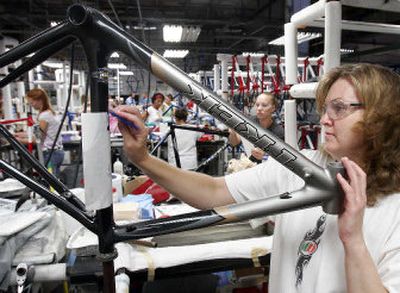Cashing in on Lance

WATERLOO, Wis. – When executives at the Trek Bicycle Corp. signed a contract with Lance Armstrong in 1998, they were betting the public would see the cyclist recovering from testicular cancer as a human interest story.
Seven years later, Armstrong is still riding a Trek manufactured in this southern Wisconsin town as he competes for his seventh straight – and last – Tour de France victory this week.
Armstrong’s prowess and personal story have reinvigorated American interest in cycling, and no company has felt the impact more than Trek, the privately held company that is the top U.S. manufacturer of bikes.
“It was just a gamble that paid off dividends that we could never imagine,” said Zapata Espinoza, a spokesman for Trek. “It was like putting a penny in a slot and winning a million bucks.”
The “Lance factor,” as Trek executives call it, is hard to quantify but has certainly been real. Combined with an aging baby-boom generation that is turning to cycling for fitness and leisure, that means big business in road bikes, the fast, lightweight cycles used by Armstrong and other world-class racers.
Road bikes, which sell for an average of $1,150, accounted for 28 percent of dollar sales by specialty dealers in 2004, up from 16 percent in 2002, according to the National Bicycle Dealers Association. Overall, the U.S. bicycling industry has remained flat since 1999, generating an estimated $5.5 billion in sales of bikes, parts and accessories in 2004, the group says.
At Trek, sales are up and the company is undergoing a major expansion that will increase the size of its headquarters in Waterloo, a town of 3,200 just 30 miles east of Madison, by about one-third.
The project, to be completed next month, will allow the factory to produce more of the lightweight carbon bikes that have become the company’s trademark around the world. The business now produces more than one million bikes per year, including road bikes, mountain bikes, and kids’ bikes.
“We have seen a significant increase in sales and production because of demand,” said company official Steve Swenson, speaking in the company’s factory in front of racks filled with finished bike frames.
Trek refused to release sales figures, but Ash Jaising, president of the Bicycle Market Research Institute in Boston, estimated Trek’s sales have increased from less than $50 million in 1990 to $500 million this year.
Jaising said the company is No. 1 in terms of units sold and value of sales in the specialty market sector, and has increased its market share to 30 percent. The company’s success has, in turn, allowed the independent bicycle dealers that sell Trek bikes to increase their market share, which had been losing ground to sporting goods stores and large retailers.
“The growth is high among the more serious bikers. People are spending more money for the equipment and that has helped Trek,” he said. “Trek has the momentum and has had it for the last couple of years.”
Trek, which started producing steel bike frames with five employees out of a red barn in 1976, now employs more than 1,500 workers, the majority of whom are in the U.S.
Armstrong is deeply involved in the designing and testing of his bikes. The Trek Madone SSLx he is riding this year, which features a stiffer frame to climb hills, will go on sale as early as next month. Previous Armstrong models have gone for up to $4,500.